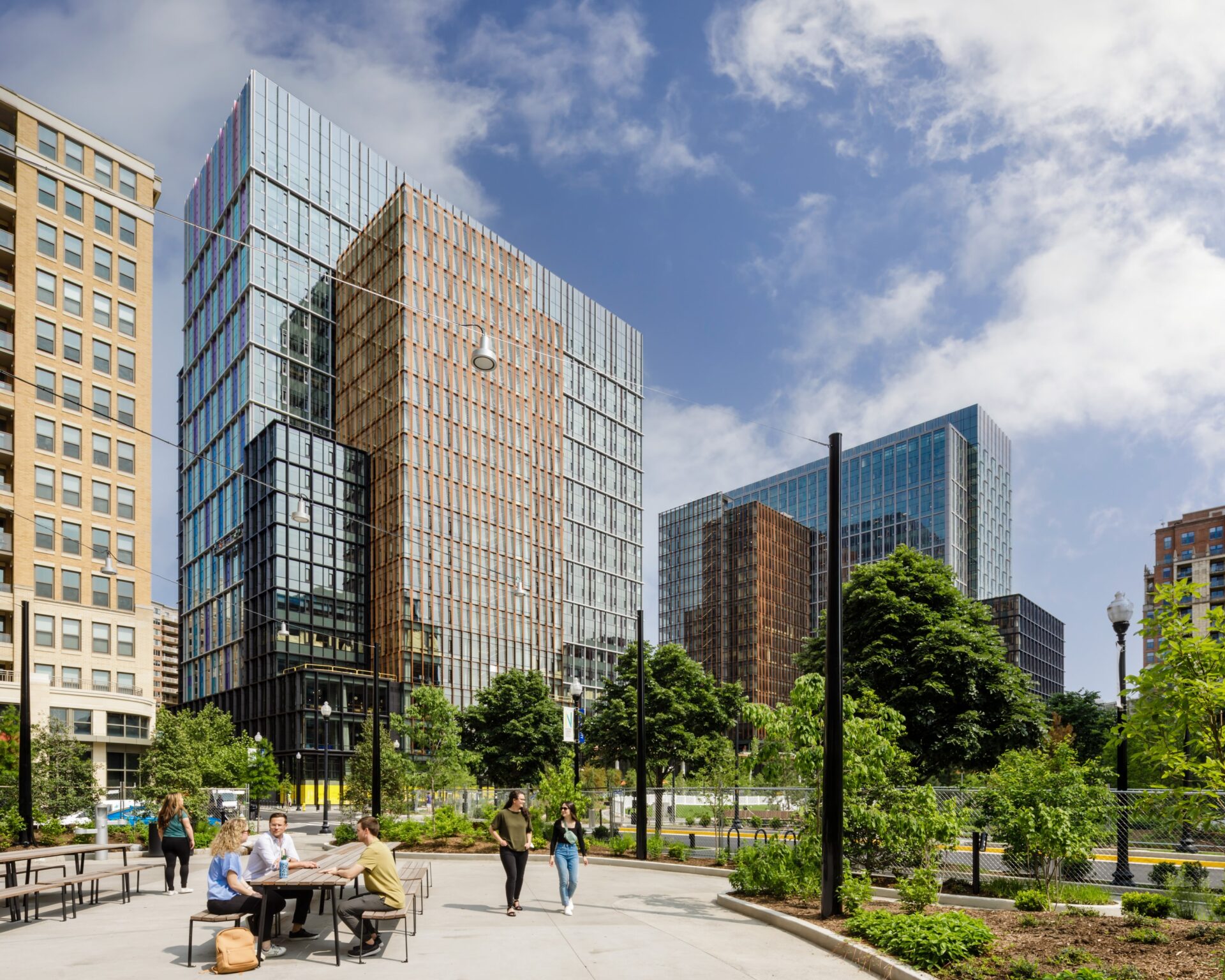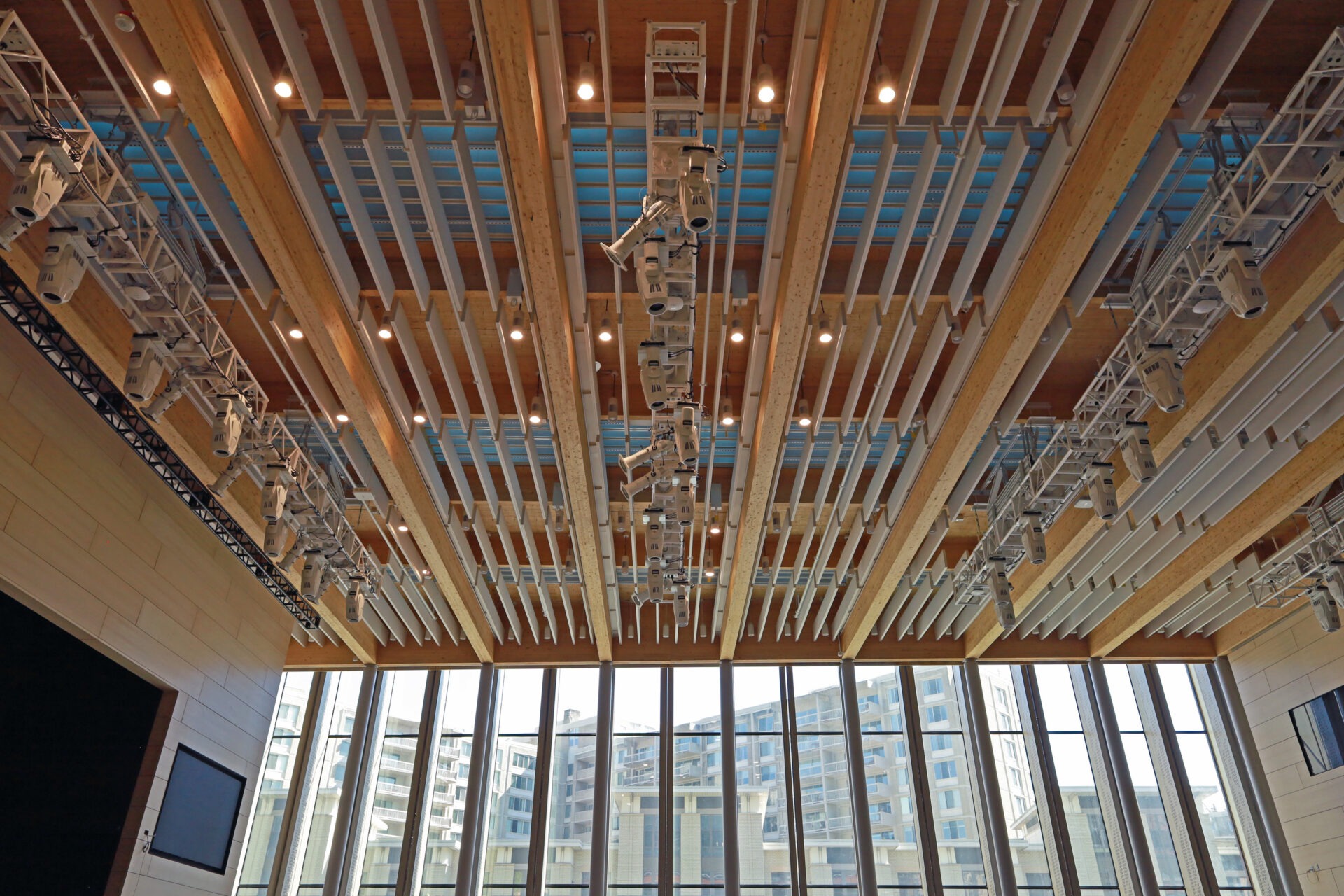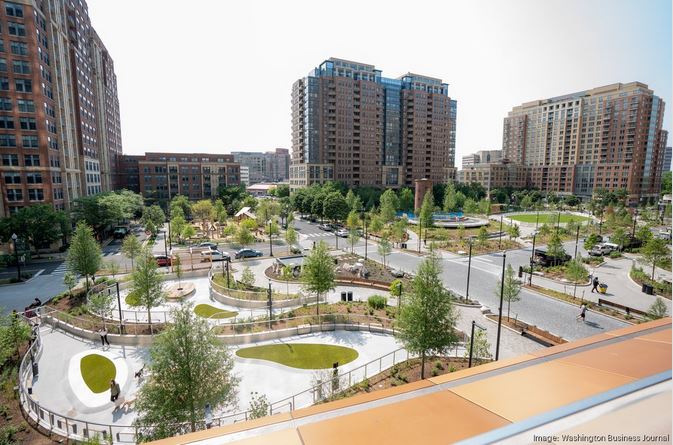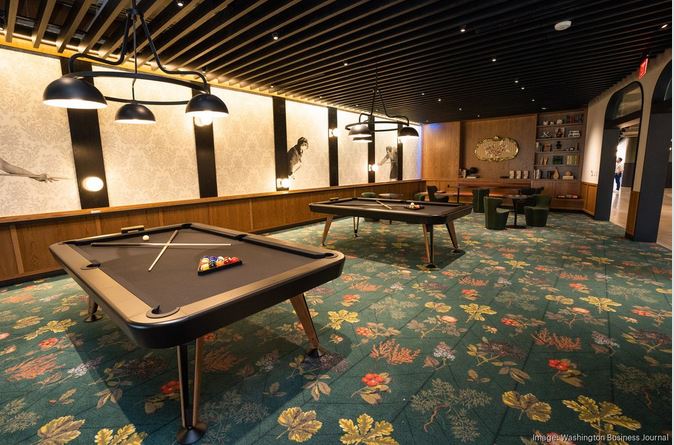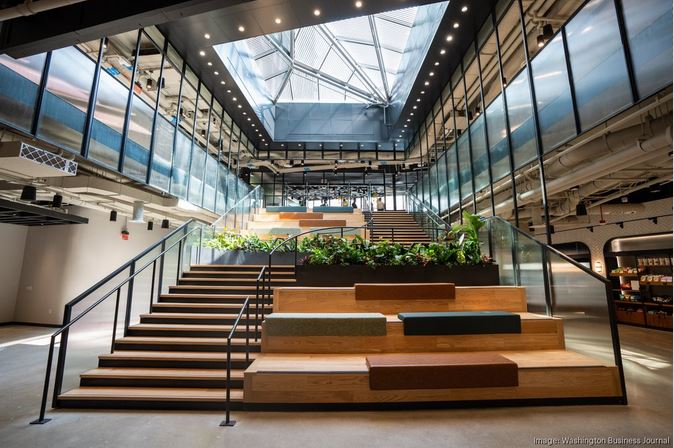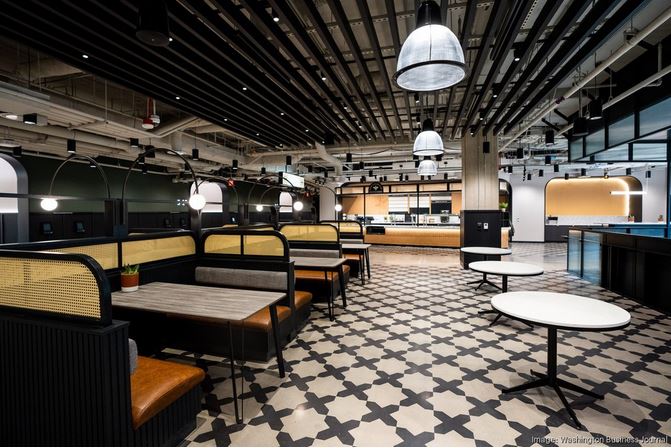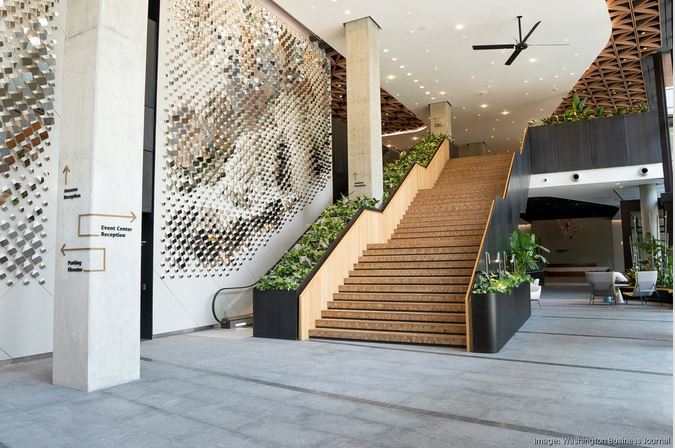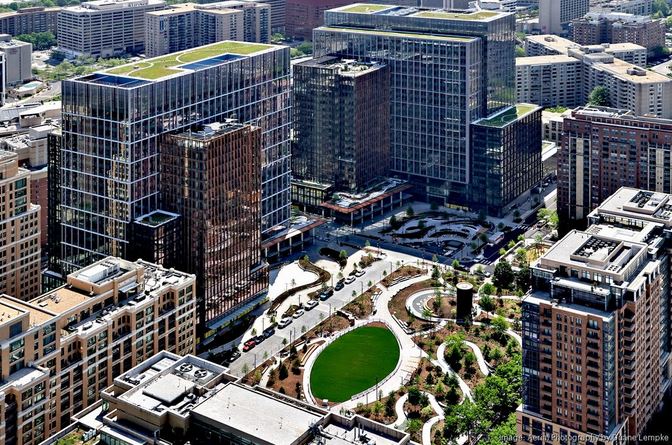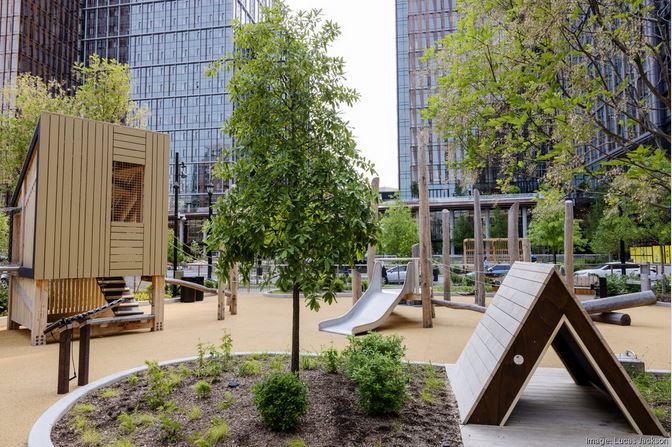[Seneca Note: Exciting day for Seneca Group and all the project partners delivering HQ2. Congratulations to Amazon and the entire SG team working on the project over the past 4 years. We are proud to have provided Amazon development management services from site evaluation and team assembly to design, permitting and construction.]
Looking out from the 15th floor of one of Amazon’s Metropolitan Park towers — the soon-to-open first phase of its long-awaited signature new HQ2 buildings — one gets a sense of the tide of change inexorably rolling across the part of Arlington and Alexandria now branded National Landing. Not just the scale of it, but also HQ2’s decisive role.
While HQ2 might not be the center of Northern Virginia’s economic solar system — that pride of place still belongs to the Pentagon — it’s impossible to dismiss Amazon.com Inc.’s symbolic weight. For many in the local business sphere, HQ2’s arrival came with the heft of Jupiter and hope of its ability to accelerate the pace of regional change and bend the arc of public and private spending, of workforce development, of political will. Little in this region of space has indeed remained unaffected since, from transit to taxes.
It’s quite the heavy mantle. And, as is expected with a project of this size, its observers are split on whether it has lived up to those high hopes — and hundreds of millions in incentive perks, cash and otherwise — and, ultimately, whether it will yield positive or negative reverberations across the region’s economy. Or perhaps a little bit of both.
Met Park — of which the Washington Business Journal got a sneak-peek tour — technically opened to workers last month. But with a more public, politico-heavy opening on the books June 15, we delve into what its arrival has meant to the metro area, beyond its promised 25,000 new jobs by 2030 and sparkly additions to the skyline. For many, the ultimate significance remains the high visibility of a tech giant planting its flag in what’s otherwise largely a government town, and what that could finally signal for Greater Washington.
“This region provides a wonderful East Coast alternative to Silicon Valley,” said Christian Dorsey, the Arlington County Board’s outgoing chair.
What’s inside?
It’s difficult to break down exactly what or who inhabits HQ2. It’s not just one or two specific corporate divisions, said Holly Sullivan, Amazon’s vice president of worldwide economic development, but instead “a true headquarters,” meaning a variety of corporate functions and “several VPs.”
Its 8,000 employees will “trickle over several months” from some 1 million square feet of leased space across six Crystal City office buildings, Sullivan said. But those reporting to the new towers thus far, as more and more floors receive their finishing touches, have already been hired. So, on its face, official Day One of Met Park’s opening won’t represent any net new people in the region — it may not even represent net new people on the streets, if the plush new digs aren’t enough to spur employees to come into the office more than the currently required three-day minimum each week.
That’s not to say Met Park’s opening is uninteresting in its own right, only that its significance goes well beyond its being a 2.1 million-square-foot pair of big trophy office towers with space, Sullivan said, “for over 14,000 employees” at its eventual full capacity.
An exclusive tour of a portion of the first tower set to open leads one through a grand entryway, sleek and modern workstations, 700-person meeting center for both employees and the public, eight food stalls or cafes, a huge room dedicated solely to interviewing prospective new hires, spaces set aside for nursing mothers, custom pieces of art etched in the floors and hanging from the ceilings — and a big public park in the middle of it all.
Perhaps what stands out most about Met Park are its many environmentally friendly design features. Among other things, the two towers will use electric-only systems, rather than those powered by fossil fuels. They’ll use 100% renewable energy from the company’s own solar farms throughout Virginia, Sullivan said. They’re built with concrete that sequesters carbon, literally having had carbon dioxide injected into it while it was mixed. Millions of gallons per year of roof runoff and other wastewater will be captured and recycled. The buildings’ windows are even said to be “bird friendly,” partially covered by architectural features to help catch our feathered friends’ attention and prevent fatal crashes.
What’s sprouting around it?
The growth around HQ2 is impossible to miss. Throw a rock in any direction from Met Park, and you’ll hit a current or future project representing a huge private or public investment.
To be clear, many were on the drawing board before Amazon (NASDAQ: AMZN) entered the picture. But HQ2 accelerated their realization, perhaps by decades, Matt Kelly, CEO of JBG Smith Properties (NYSE: JBG), said in an interview. His real estate giant is Amazon’s current landlord, the master developer of its new HQ2 buildings and the driving force for millions of square feet of other development in Met Park’s immediate vicinity. The second headquarters was enough to catapult forward a business-model shift for JBG Smith, which recorded $153 million in first-quarter revenue this year, as it exited much of its D.C. holdings to concentrate two-thirds of its nearly 10 million-square-foot portfolio within National Landing’s borders.
For JBG Smith’s part, while the developer already had big plans for its assets in those neighborhoods, Amazon’s promised hiring gave it “confidence that we could accelerate the construction starts and delivery of new housing in particular, and new retail,” rather than “dribble it out, one every couple of years,” Kelly said. Likewise, infrastructure improvements the state promised to help lure Amazon hastened dreamed-of projects that otherwise didn’t have identified funding, he added.
Consider the initiatives afoot near Met Park. A new Crystal City “transit hub” is in the works, which aims to bring together several rail services, including the Amtrak’s Acela. U.S. Route 1 is getting lowered to grade level, which will not only help integrate the streets and buildings on either side of it — good news for street-level retailers who look to benefit from fewer pedestrian impediments — but, Kelly said, will also free on- and off-ramp footprints for even more new development. A little south of Met Park, toward the other end of National Landing, the Potomac Yard Metro station, a pillar of Alexandria’s economic development aspirations, just opened to its own fanfare.
Right next to that new station, Virginia Tech’s $1 billion innovation campus, which is anticipated to feed Amazon’s and other big regional companies’ tech-savvy workforce needs, is taking shape. Kelly said that campus, part of Virginia’s pitch to win HQ2 in the first place, may over the long term “dwarf” National Landing’s various infrastructure improvements in economic significance, as it “will become the attraction that other employers want to be near.”
“If it weren’t for Amazon, I think in some cases we’d probably still be talking about these, as opposed to doing” them, Kelly said. Even so, “we’re just really still at the beginning.”
What’s its longer-term effect?
Beyond the real estate milieu is Amazon’s clout as a tech colossus, anticipated to attract additional private sector tech might to the region. Its efficacy in that regard is still too early to gauge now, many say.
Regardless, Amazon, drawn here at least in part by a highly educated workforce and government research and development funding institutions like the National Science Foundation and Defense Advanced Research Projects Agency that spawned technologies from the internet to GPS, has offered this region a “stamp of approval,” according to Christina Winn, Prince William County’s economic development director. In 2018, she served as Arlington Economic Development’s business investment director and was intimately involved in pitching Amazon, with the hopes that the global giant could put Northern Virginia on the map in a new way, as a potential global tech capital, she said.
Dorsey of the Arlington Board noted there are myriad ways to get to 25,000 new jobs in a locality, including adding “a hundred 250-person small businesses.” That still would have represented a big economic infusion to the area — the falafel guy would get the same new lunchtime customer base, office landlords would still get new tenants. But a hundred small businesses don’t add up to a Silicon Valley alternative, supporters point out.
In the end, whether or not Met Park opening is good or bad depends on one’s point of view and, more likely, an incalculable sum total of trade-offs. To the extent HQ2’s advent will indeed make Greater Washington a viable alternative to Silicon Valley, consider the population, high-wage pressure and cost of living increases the San Francisco Bay Area has experienced in recent memory — it’s not difficult to imagine that everyone might not fawn over the prospect of a similar transformation here.
Amazon is also facing criticism over its management of unionization efforts around the country, accused of attempting to quash them, which it refutes. It’s drawn the ire of D.C.’s attorney general’s office, and just last month, the company agreed to pay
$30.8 million to settle a Federal Trade Commission complaint that its Ring doorbell videos violated privacy. Amazon denied those claims and said its settlement was meant to “put these matters behind us,” in a statement.
But for some, the most agonizing downside remains the cash subsidies Amazon extracted in its deal with the state during its 2018 nationwide HQ2 search — up to $750 million, if the company hits its full job creation targets. The commonwealth may have offered up one of the smaller packages, but if it all comes to pass, Virginia would essentially have reimbursed nearly one-third of the $2.5 billion HQ2 price tag for a corporate titan whose net sales in 2022 exceeded $500 billion and whose $3.2 billion in first-quarter profits this year equated to Aruba’s entire GDP.
While some of the state’s investments in infrastructure and education will benefit companies and the general public more broadly, Greg LeRoy, executive director of Good Jobs First, cringes at the corporate cash incentives. He affirmed Northern Virginia’s basic economic wisdom in trying with HQ2 to diversify itself beyond Uncle Sam. But he called Amazon’s incentive negotiations “disrespectful,” saying he’s at a loss to understand why the corporation “jerked everybody around” during the bidding process, during which numerous cities offered far more generous subsidies.
While Sullivan said candidly that HQ2 “most likely” would have gone elsewhere if Virginia hadn’t offered the incentives it did, LeRoy said he believes the fact that Amazon accepted the state’s “comparatively stingy deal” suggests the company had intended to land here regardless, probably to be close to the region’s well-educated workforce and the feds. The subsidies make it “a retail company growing at the expense of other retailers,” he said.
“Philosophically, I wish that we didn’t have such a thing as incentives like that,” Terry Clower, director of the Center for Regional Analysis at George Mason University, said in an interview. “If I could wave a magic wand and say that states weren’t allowed to compete with each other, and that companies had to just make rational decisions based on tax policies, as opposed to local governments and state governments picking winners and losers among which industries they want to incentivize the most — yeah, that would be great.”
But, at the end of the day, “it’s what we live in,” he said. “You can sit on your high horse and then watch that investment and those jobs go someplace else.”
HQ2 needs more employees before Amazon grows a tail
The HQ2 dream, for those in Arlington and beyond, was not only direct economic development through Amazon.com Inc.’s hiring but a domino effect of other companies following its lead to the area, a tech tail, so to speak.
During an earnings call in the first quarter of 2019, Matt Kelly, CEO of JBG Smith Properties, the development manager for both phases of Amazon’s second headquarters and the dominant commercial property owner in National Landing, teased investors with the promise of “the dynamic technology ecosystem we are creating.” In its earnings report for that quarter, JBG Smith projected that 2.2 million square feet of new office in National Landing, not including HQ2 itself, could be pre-leased to Amazon or “other tenants seeking to co-locate near Amazon.” The e-commerce giant’s arrival, he added, “may also drive increases in the value of assets in other nearby submarkets,”
But that was before the pandemic, the surge of remote work and related economic strife, the combination of which has slowed growth, overhauled recruitment and retention strategies, and even changed what and where a headquarters can be. That doesn’t mean HQ2 won’t eventually become a magnet. It just means it’s going to take time as Amazon continues to grow.
Eventually, public and private sector leaders hope Amazon will do for Greater Washington’s tech sector what the Pentagon did for the defense contracting sector. Last year, Raytheon Technologies Corp. and The Boeing Co. both relocated their headquarters to Arlington — Boeing to Crystal City and Raytheon to Rosslyn. With those moves, the D.C. area is now home to the top five U.S. aerospace and defense contractors.
The most recent shifts came with no massive employee surge or ribbon cutting of new facilities. The Boeing and Raytheon arrivals were largely symbolic — both companies already had a sizable presence here — but not without meaning.
Terry Clower, director of the Center for Regional Analysis at George Mason University, views both as more than just bragging rights. The arrivals are a message that the D.C. area has a strong talent base to feed the corporate pipeline, he said. The pandemic has shifted the paradigm, in Clower’s opinion, where “companies are more and more moving to where the skilled employees are, as opposed to skilled employees moving to where the companies are.”
Once Amazon hits that critical mass of employees, he expects, that’s when the economic development ball will start rolling, and the tech tail will grow. — Donte Kirby
